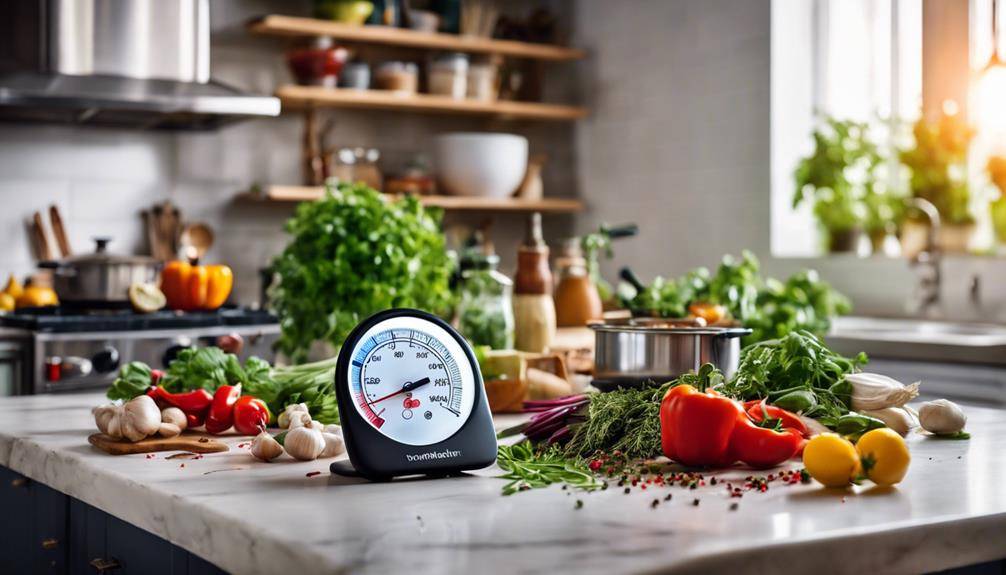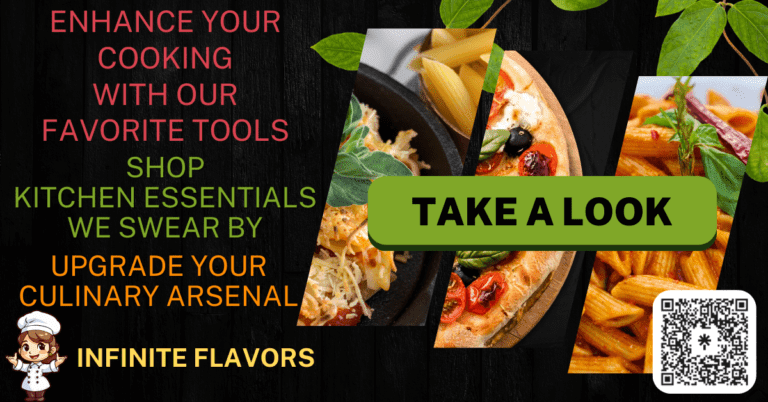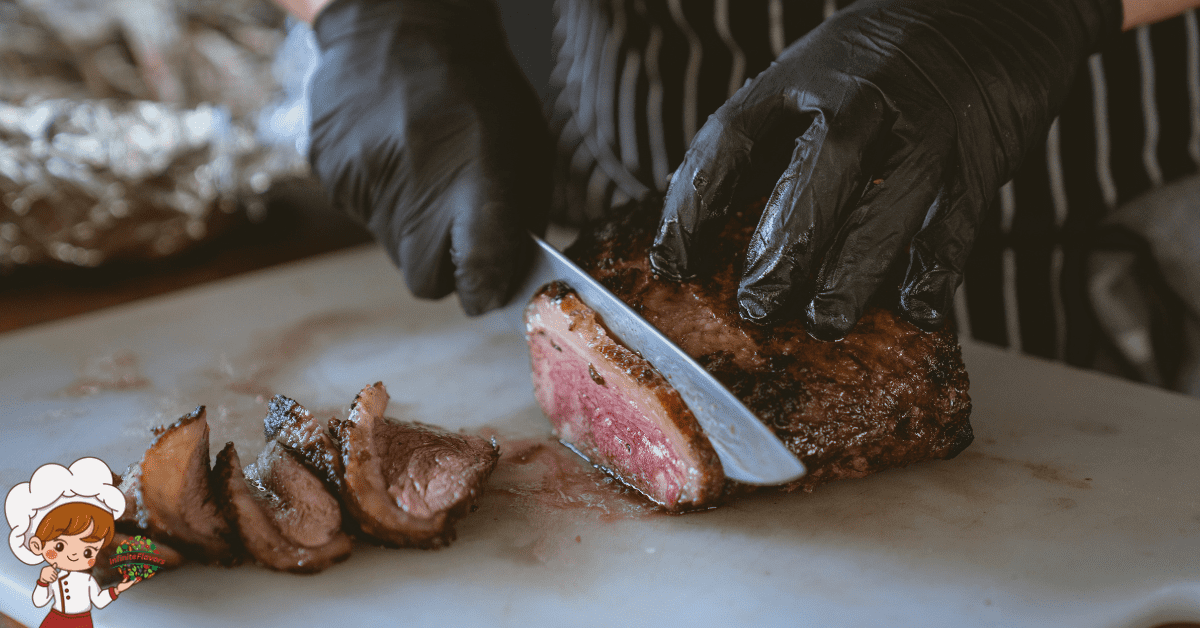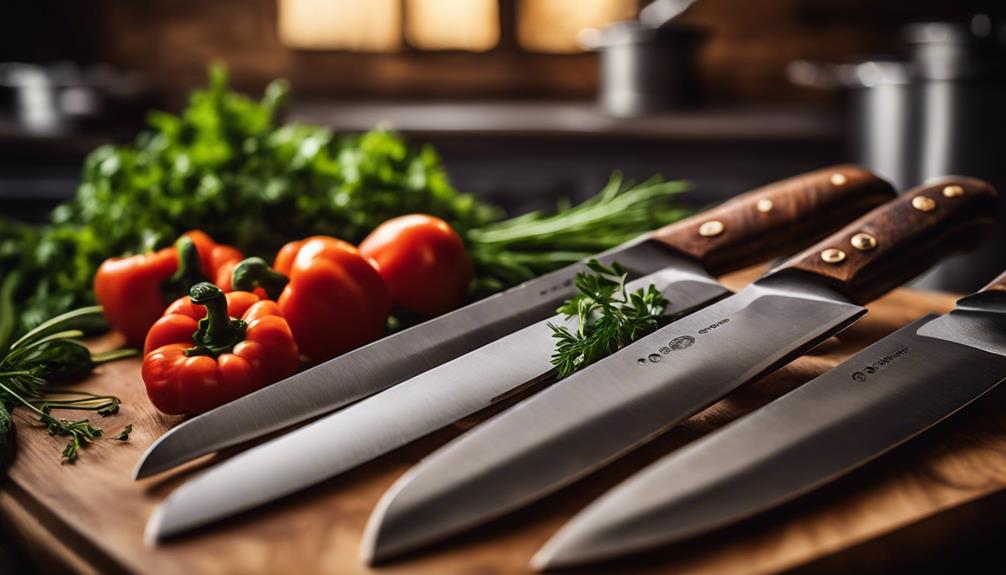Great Reviews Of Multipurpose Kitchen Thermometers

When it comes to Reviews Of Multipurpose Kitchen Thermometers, user reviews highlight their importance in enhancing cooking safety and quality. You’ll find that digital models are praised for their quick, precise readings, while analog options are valued for their durability. Features like instant-read capabilities and Bluetooth connectivity have received positive feedback for convenience. Customers note the variety of designs, ensuring ease of use and cleaning. Many recommend trusted brands like ThermoPro and OXO for their accuracy and reliability. If you want to explore specific models and tips for maximizing your cooking experience, there’s plenty more to discover about these handy tools.
Importance of Kitchen Thermometers
Kitchen thermometers are essential tools for any home cook or professional chef. They play an important role in guaranteeing cooking safety and maintaining food quality. When you’re cooking meat, poultry, or seafood, using a thermometer helps you avoid undercooking or overcooking, which can lead to foodborne illnesses or dry, unappetizing meals. By monitoring the internal temperature, you can confidently serve dishes that are safe to eat while also achieving the desired texture and flavor.
Imagine pulling a perfectly cooked roast chicken out of the oven, knowing it reached the recommended internal temperature. You’d feel proud, and your guests would appreciate the effort. A thermometer takes the guesswork out of cooking, allowing you to focus on other important tasks in the kitchen. When you know the right temperatures for various foods, you can enhance the overall quality of your meals.
Additionally, kitchen thermometers are versatile and can be used for a variety of cooking methods, from grilling to baking. They’re not just about safety; they’re about elevating your culinary skills. With a precise reading, you can confirm that delicate dishes like custards or confections reach the ideal temperature for prime texture and flavor.
Incorporating a reliable kitchen thermometer into your routine is a smart investment. It assures that you’re not only cooking safely but also achieving the best possible results in your culinary endeavors. So go ahead, elevate your cooking game with this indispensable tool.
Types of Multipurpose Thermometers
When choosing a multipurpose kitchen thermometer, you’ll encounter both digital and analog models, each with its own benefits. Instant-read features can make a significant difference in your cooking experience, saving you time and ensuring accuracy. Plus, the length of the probe can affect how you measure temperatures in various foods, so it’s worth considering.
Digital Vs. Analog Models
Two main types of multipurpose kitchen thermometers dominate the market: digital and analog models. Each has its unique features, catering to different cooking preferences. Digital thermometers offer significant digital display advantages, such as quick readings and easy-to-read screens. You’ll appreciate how fast they respond, allowing you to check the temperature of your food without any hassle, especially when you’re in a rush.
On the other hand, analog models boast analog durability benefits. These thermometers often have fewer electronic components, making them more robust and less likely to break if dropped. If you value longevity and reliability, an analog thermometer might be the right choice for you. They can handle the rigors of a busy kitchen without needing batteries or frequent replacements.
Ultimately, your choice between digital and analog models will depend on your cooking style. If speed and convenience are essential, you’ll likely lean toward digital. However, if you prefer a sturdy tool that can withstand years of use, an analog thermometer might suit you better. Assess your cooking habits and choose the thermometer that best fits your needs.
Instant-Read Features Explained
Instant-read thermometers are essential tools for any cook who wants precise temperature measurements without the wait. These devices are designed to give you instant read accuracy, making them perfect for checking the doneness of meats, baked goods, or candy. When you use an instant-read thermometer, you’ll appreciate how quickly you can gauge the temperature, helping you avoid undercooking or overcooking your dishes.
Typically, these thermometers feature a sharp probe that you insert into your food. With just a simple press of a button, you’ll get a reading in seconds, allowing for quick temperature retrieval. Many models even come with backlit displays, making it easy to read the temperature in low light.
You’ll find that instant-read thermometers are versatile, allowing you to use them in various cooking situations, from grilling to baking. Since accuracy is key in cooking, investing in a quality instant-read thermometer can elevate your culinary skills. With this handy tool in your kitchen, you can guarantee that every dish you serve is cooked to perfection.
Probe Length Considerations
Choosing the right probe length is essential for getting accurate temperature readings in various cooking scenarios. If you’re grilling thick cuts of meat, for instance, a longer probe helps you reach the center without burning your hand. Conversely, when checking the doneness of smaller items, a shorter probe might suffice.
When considering probe material, stainless steel is a popular choice for its durability and quick heat response. You’ll want to guarantee that it’s designed for the specific foods you’re cooking, as certain materials hold up better in high heat or acidic environments.
Probe flexibility options are also important. A rigid probe works well for solid foods, while a flexible one can be beneficial for items like roasts or delicate fish. Flexibility can help you navigate around bones and joints, making sure you get an accurate reading without damaging the food.
Ultimately, the right probe length, coupled with appropriate material and flexibility, can enhance your cooking experience. So, take the time to choose wisely, and you’ll enjoy perfectly cooked meals every time!
Features to Consider
When selecting a multipurpose kitchen thermometer, it’s essential to evaluate several key features that can enhance your cooking experience. One of the first things to take into account is the sensor technologies used in the thermometer. Look for thermometers that utilize advanced sensor technologies, as they often provide more accurate readings and faster response times. This can be particularly important when you’re cooking meats or baking delicate pastries where precision is key.
Next, examine the temperature ranges the thermometer can measure. A good multipurpose thermometer should cover a wide range, from very low temperatures for candy making to high temperatures suitable for grilling and roasting. This versatility will allow you to tackle a variety of recipes without needing multiple devices.
Another feature worth reflecting on is the display. A clear, easy-to-read display can make a significant difference, especially in busy kitchen environments. Some models also offer backlit screens, which can be a lifesaver when you’re cooking in low-light conditions.
Don’t forget about the response time. Some thermometers can take several seconds to register a temperature, while others can provide readings in just a few seconds. The quicker, the better, as it allows you to make timely decisions while cooking.
Lastly, think about the ease of cleaning and storage. A thermometer that’s easy to clean and comes with a protective case can save you hassle in the long run. By reflecting on these features, you’ll make sure you choose a thermometer that meets your cooking needs effectively.
Digital Vs. Analog Thermometers
In the debate between digital and analog thermometers, each type offers distinct advantages that cater to different cooking styles and preferences. Digital thermometers, equipped with advanced sensor technology, provide quick and precise readings. You can often expect results within seconds, which is perfect for busy cooks needing instant feedback. The easy-to-read LCD screens minimize guesswork, ensuring you get accurate temperatures at a glance. Many digital models also come with features like programmable alerts and backlighting, making them user-friendly even in low-light conditions.
On the other hand, analog thermometers have their own charm. They typically involve a dial that shows the temperature, which some users find easier to interpret at a distance. With no reliance on batteries or electronics, analog models are often seen as more durable and reliable in certain cooking environments, like outdoor grilling. If you prefer a classic approach, you might appreciate the tactile experience of an analog thermometer.
Ultimately, your choice between digital and analog thermometers hinges on your cooking habits and user preferences. If you value speed and precision, a digital model might be your best bet. However, if you appreciate simplicity and a timeless design, an analog thermometer could be the right fit. Both types serve their purpose well; it’s all about what aligns with your cooking style and needs.
Top Thermometer Recommendations
Finding the right thermometer can elevate your cooking experience, whether you’re a novice or a seasoned chef. In your kitchen, you’ll want a thermometer that covers a wide variety of temperature ranges to suit different cooking methods. Here are some top recommendations that can help you achieve perfect results every time.
First, consider the ThermoPro TP03A. This instant-read thermometer provides quick readings within 2-3 seconds and covers temperatures from -58°F to 572°F. It’s perfect for grilling, baking, or making candy. The foldable probe makes it easy to store, and its backlit display guarantees you can read it in any lighting.
Another great option is the Maverick ET-733. This wireless thermometer allows you to monitor your meat from up to 300 feet away, making it ideal for outdoor cooking. With a temperature range of 32°F to 572°F, it works well for various cooking methods, whether you’re roasting a turkey or smoking ribs.
If you’re looking for versatility, the OXO Good Grips Chef’s Precision Digital Instant Read Thermometer is excellent. It features a temperature range from -40°F to 450°F and a rotating display for easy reading, regardless of how you’re holding it.
Instant-Read Thermometers
Instant-read thermometers are a game changer for anyone who wants to cook with precision and confidence. These handy devices give you quick and accurate readings, allowing you to master various cooking techniques without second-guessing yourself. Whether you’re grilling, roasting, or baking, knowing the exact temperature of your food is essential for achieving the best results.
When you use an instant-read thermometer, you’re not just checking if your dish is done; you’re ensuring it’s cooked to perfection. Most models cover a wide range of temperature ranges, from rare meats to perfectly baked desserts. You can easily gauge whether your steak is medium-rare at 130°F or if your bread has reached that golden 190°F.
One of the biggest advantages of instant-read thermometers is their speed. Unlike traditional thermometers that can take minutes to deliver a reading, these devices provide results in just a few seconds. This quick feedback is especially beneficial when you’re working with multiple dishes or trying to keep things moving in a busy kitchen.
To get the most out of your instant-read thermometer, insert the probe into the thickest part of the food, avoiding any bones or fat, as they can affect the accuracy. With just a little practice, you’ll find that using an instant-read thermometer will elevate your cooking skills and enhance your overall culinary experience. You’ll feel more in control and less anxious about serving undercooked or overdone meals.
Probe Thermometers
When it comes to probe thermometers, you’ll find various types designed to suit different cooking needs. Understanding their accuracy and how to calibrate them is key to getting reliable readings. Plus, knowing some usage tips and techniques can help you make the most of this essential kitchen tool.
Types of Probe Thermometers
Probe thermometers come in various types, each designed to meet specific cooking needs. One common type is the instant-read thermometer, perfect for quickly checking the temperature of meats and other dishes. These thermometers often feature digital accuracy, allowing you to get precise readings in seconds. You’ll appreciate their ergonomic designs, making them easy to grip and use without fumbling.
Another type is the dial probe thermometer, which provides a more traditional approach. While they may take a bit longer to deliver readings, they’re reliable for checking larger cuts of meat. Some models come with a protective sheath, ensuring safe storage.
For those who love multitasking, the wireless or Bluetooth probe thermometers are a game-changer. You can monitor cooking temperatures from a distance, allowing you to enjoy socializing while keeping an eye on your food. Many of these models have digital accuracy and can alert you when your dish reaches the desired temperature.
Lastly, you might consider a probe thermometer with multiple probes, ideal for cooking various items simultaneously. This versatility makes them invaluable in the kitchen, especially during holiday gatherings or big family meals.
Accuracy and Calibration
Accurate temperature readings are crucial for safe and successful cooking, making calibration an important aspect of using probe thermometers. To guarantee your thermometer provides precise measurements, you’ll want to familiarize yourself with effective calibration techniques. Regular calibration helps maintain accuracy, especially if you’ve dropped your device or used it frequently.
One common method for accuracy testing is the ice water method. Fill a glass with ice and add cold water, then let it sit for a few minutes. Insert your thermometer’s probe into the ice water, making sure it doesn’t touch the sides or bottom of the glass. It should read 32°F (0°C). If it doesn’t, adjust your thermometer according to the manufacturer’s instructions.
Another technique is the boiling water method. Boil a pot of water and insert the probe. It should read 212°F (100°C) at sea level. Again, if it’s off, make the necessary adjustments. Consistently checking your probe thermometer for accuracy guarantees you’re cooking safely and effectively, ultimately leading to better results in your culinary endeavors. So, don’t skip this crucial step in your cooking routine!
Usage Tips and Techniques
Mastering the art of using a probe thermometer can greatly enhance your cooking experience. To start, always insert the probe into the thickest part of the food, avoiding bone and fat, to guarantee accurate readings. For meats, you’re aiming for specific internal temperatures to guarantee cooking safety. For example, chicken should reach at least 165°F, while medium-rare beef is best at 130°F.
When you first insert the probe, give it a moment to stabilize. Don’t rush; accurate temperature monitoring is key. If you’re using a digital thermometer, check if it has a quick-read feature to save time. Also, consider using a thermometer with an alarm to notify you when your food reaches the desired temperature.
After you’ve finished cooking, always clean your probe thoroughly to prevent cross-contamination. A little soap and water will do the trick, or you can wipe it down with alcohol wipes. Finally, don’t forget to calibrate your thermometer regularly to maintain its accuracy. With these tips, you’ll not only cook delicious meals but also prioritize cooking safety, guaranteeing your food is both tasty and safe to eat.
Infrared Thermometers
Using infrared thermometers can revolutionize how you check temperatures in the kitchen. Unlike traditional thermometers, these devices utilize infrared technology to measure the temperature of surfaces without direct contact. This means you can quickly gauge the temperature of foods, pots, and pans, making it a breeze to verify everything’s cooked to perfection.
One of the standout features of infrared thermometers is their ability to deliver instant results. With just a pull of the trigger, you get an accurate temperature measurement in seconds. This is particularly useful when you’re multitasking in the kitchen and need to keep things moving. You can easily check the temperature of a sizzling skillet or the doneness of your roast without interrupting the cooking process.
Another advantage is the safety factor. Since you won’t need to touch hot surfaces, you reduce the risk of burns and accidents. This is especially helpful when working with high-heat cooking methods like frying or broiling. Plus, infrared thermometers are versatile; they can be used for more than just food. You can check the temperature of ovens, grills, and even the ambient temperature of your kitchen.
Incorporating an infrared thermometer into your cooking routine can streamline your meal prep and enhance your culinary precision. Whether you’re a home cook or a seasoned chef, having this tool at your disposal can make a significant difference in how you manage temperature measurement in your kitchen.
Bluetooth and Smart Thermometers
Bluetooth and smart thermometers are transforming the way you monitor cooking temperatures in the kitchen. With Bluetooth connectivity, you can easily sync your thermometer to your smartphone or tablet, allowing you to track temperatures without hovering over the stove. Smart app integration enhances your experience, enabling you to set cooking mode settings for various dishes, from meats to desserts.
However, it’s important to be aware of wireless range limitations. If you step too far away from the base unit, the connection may drop, potentially leading to missed alerts. Battery life considerations are also significant; look for models that offer extended battery life or rechargeable options to avoid interruptions during cooking.
One of the standout features is the temperature alerts feature, which notifies you when your food reaches the desired temperature, ensuring perfectly cooked meals every time. Many smart thermometers support multiple device compatibility, so you can monitor several dishes simultaneously, making them ideal for multitasking.
User interface design plays a significant role in usability, with intuitive layouts making it easy to navigate settings and check readings. Data logging capabilities allow you to review past cooking sessions, helping you improve your culinary techniques. Plus, remote monitoring options let you keep an eye on your meal from anywhere in your home, giving you more flexibility and freedom in the kitchen. Embracing Bluetooth and smart thermometers can elevate your cooking game and streamline your kitchen experience.
User-Friendly Designs
When it comes to kitchen thermometers, user-friendly designs are essential for a seamless cooking experience. You want a thermometer that not only provides accurate readings but is also easy to handle and operate. Look for models featuring ergonomic grips, as these guarantee comfort during use, especially when you’re checking the temperature of a hot dish or grilling meat. A well-designed grip helps you maintain control, preventing slips and spills that could disrupt your cooking.
Intuitive interfaces are another key component of a user-friendly thermometer. You shouldn’t have to struggle to understand how to operate your device. A straightforward display with clear, easy-to-read numbers makes all the difference. Thermometers with simple buttons or touchscreens allow you to navigate settings quickly, so you can focus on getting your dish just right.
Moreover, consider the size and weight of the thermometer. Lightweight models are easier to maneuver, while compact designs save space in your kitchen. Some thermometers even come with built-in features like timers or alarms, which can enhance your cooking process without adding complexity.
In essence, a user-friendly kitchen thermometer combines ergonomic grips and intuitive interfaces, making it a joy to use. This thoughtful design guarantees that you can cook with confidence, knowing that you have the right tools at your fingertips. So, as you shop for your next thermometer, keep these aspects in mind to elevate your culinary adventures.
Maintenance and Care Tips
Proper maintenance and care of your kitchen thermometer guarantees it remains reliable for all your cooking needs. Start by implementing effective cleaning methods after each use. If your thermometer is waterproof, rinse it under warm water. For non-waterproof models, use a damp cloth and mild soap to wipe the exterior, avoiding the probe area. Always sanitize the probe with a solution of 1 tablespoon of bleach mixed with 1 gallon of water, making certain it’s safe for food contact.
When it comes to storage solutions, choose a safe place that prevents damage. You can store your thermometer in a drawer, but make sure it’s in a protective case or sleeve to avoid accidental bending or breaking of the probe. If your thermometer comes with a clip, consider attaching it to a hook or magnetic strip for easy access and to keep it off the counter where it could get soiled.
Check the battery regularly, especially if you use a digital thermometer. Replace it as needed to guarantee accurate readings. If you notice any discrepancies in temperature readings, recalibrate your device according to the manufacturer’s instructions.
Lastly, always refer to your thermometer’s user manual for specific care guidelines. By following these maintenance and care tips, you’ll not only prolong the life of your kitchen thermometer but also guarantee it consistently delivers precise results for all your culinary endeavors.
Pricing and Value Comparisons
When you’re looking for a kitchen thermometer, you’ll find plenty of budget-friendly options that can get the job done. However, it’s worth considering premium features that may enhance your cooking experience and save you time. Investing in a high-quality thermometer can pay off in the long run, ensuring accuracy and durability.
Budget-Friendly Options Available
Finding budget-friendly kitchen thermometers doesn’t mean sacrificing quality or accuracy. Many affordable brands offer reliable options that can help you achieve perfect cooking results without breaking the bank. Brands like ThermoPro and Lavatools provide excellent thermometers at reasonable prices, making them a popular choice among home cooks.
When shopping for budget-friendly options, pay close attention to user reviews. These insights can reveal how well a thermometer performs in real kitchen scenarios. You’ll find that many users praise the accuracy and speed of these affordable models, often stating they were pleasantly surprised by their performance.
For instance, some budget models feature instant-read capabilities, giving you precise temperature readings in just seconds. Others come with handy features like backlit displays or magnetic backs, enhancing their usability.
Premium Features Worth Considering
While budget-friendly kitchen thermometers are great for everyday use, investing in premium models can elevate your cooking experience greatly. Premium thermometers often come equipped with advanced safety features, such as automatic shut-off and waterproof designs, ensuring your device lasts longer and remains reliable in the kitchen. These enhancements not only improve usability but also give you peace of mind while cooking.
When comparing pricing, consider the long-term value these premium options can provide. They typically offer quicker response times and more accurate readings, which can greatly affect the quality of your dishes. Plus, you’ll find that many premium models have user reviews that highlight their durability and precision, reinforcing the idea that they’re worth the investment.
Additionally, premium thermometers often include features like Bluetooth connectivity and smartphone compatibility, letting you monitor your cooking from a distance. This level of convenience makes them ideal for serious cooks who want to take their culinary skills to the next level. By weighing the safety features and user reviews against the price, you’ll be better equipped to choose a kitchen thermometer that truly enhances your cooking experience.
Long-Term Investment Benefits
Investing in a premium kitchen thermometer can considerably enhance both your cooking and your wallet over time. While the initial price might seem higher, the long-term benefits far outweigh the upfront cost. A high-quality thermometer not only guarantees precise cooking but also leads to significant cost savings. You’ll waste less food due to undercooking or overcooking, which can add up over time.
Moreover, these thermometers often boast energy efficiency features. By accurately measuring temperatures, you can optimize cooking times and reduce energy consumption, leading to lower utility bills. For instance, knowing the exact moment your dish reaches the desired temp means you won’t need to keep your oven running longer than necessary.
When comparing prices, consider that cheaper models may require frequent replacements and could lack the accuracy of premium options. Investing in a reliable thermometer means fewer replacements and less frustration in the kitchen. Ultimately, by prioritizing quality, you’re making a smart financial decision that pays off in both your cooking results and your budget. So, weigh the costs carefully, and you’ll find that a premium kitchen thermometer is a worthy, long-term investment.
Frequently Asked Questions: Reviews Of Multipurpose Kitchen Thermometers
Can Kitchen Thermometers Be Used for Non-Food Applications?
Absolutely, you can use kitchen thermometers for non-food applications! Their versatility makes them handy for various tasks, like checking the temperature of liquids, batteries, or even heating elements. Get creative with their functions!
How Do I Calibrate My Kitchen Thermometer?
To calibrate your kitchen thermometer, use ice water or boiling water as calibration methods. Submerge the probe, checking the readings against expected temperatures. Adjust as needed to guarantee accurate thermometer performance for your cooking needs.
What Is the Lifespan of a Typical Kitchen Thermometer?
A typical kitchen thermometer lasts about five to ten years, depending on usage. Regular battery replacement helps maintain accuracy, so keep an eye on performance. With proper care, you can extend its lifespan considerably.
Are There Specific Thermometers for Baking Versus Cooking?
Yes, there are specific thermometers for baking and cooking. Baking thermometers often measure oven temperatures accurately, while cooking thermometers are designed for meat and liquids. Choosing the right one enhances your culinary success.
Can I Wash My Thermometer in the Dishwasher?
You shouldn’t wash your thermometer in the dishwasher. Most thermometer materials aren’t dishwasher safe and can get damaged. Instead, hand wash it with warm soapy water to guarantee it stays in good condition.
Conclusion
In summary, choosing the right multipurpose kitchen thermometer can elevate your cooking and guarantee food safety. With various types and features available, you can find one that suits your needs, whether you prefer digital or analog. Remember to take into account smart options for added convenience. By keeping maintenance in mind and comparing prices, you’ll make an informed decision that adds value to your kitchen. So, gear up and enjoy the precision that a good thermometer brings to your culinary adventures!








